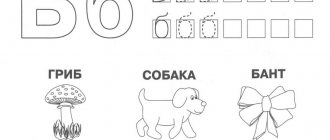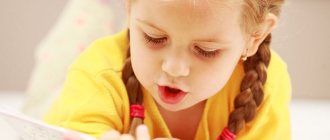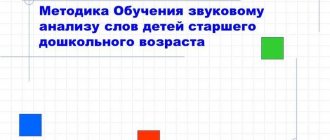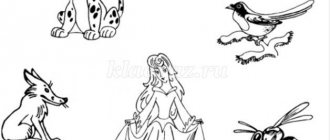Article:
Topic: Sound U. Letter U. Goals: Correctional and educational:
- Introduce children to the sound u, the way of characterizing it based on articulation;
- Reinforce the concept of “vowel sound”, “word”;
- Introduce the letter U.
Correctional and developmental:
- Develop general, fine, facial and articulatory motor skills;
- Develop breathing and voice;
- Develop phonemic hearing, phonemic perception;
- Develop visual and figurative thinking;
- Develop the ability to form and use plural nouns.
Correctional and educational:
- To develop in children the ability to listen carefully to the teacher’s speech.
Equipment : subject pictures with the sound U at the beginning of the word (stress position): beehive, duck, ear, etc.; diagram for characterizing sounds, colored chips for designating sounds and drawing up diagrams, the letter U.
- Organizing time.
Game "Recognize by voice." -The speech therapist invites the children to stand in a circle. One of them goes out into the circle, closes his eyes and guesses by his voice who called him. 2. Main part.
- Mimic gymnastics “Oak”.
Oak of rain and wind. Bold facial expression. Not afraid at all. Who said that oak is Fear. Scared of catching a cold? After all, it remains green until late autumn. Joy. This means the oak is hardy, this means it is hardened. Pride.
- Articulation gymnastics
The teacher suggests performing a series of articulation exercises in front of the mirror: “Fence” - “Window” - “Bridge” - “Shovel” - “The shovel digs” - “Tasty jam”. The complex is repeated 4 times.
- Song "Musical voice" with movements.
The A-fingers are widely spaced; The O-fingers are gathered into a ring; The hand is clenched into a fist; I-thumb and little finger exposed; E-“soft” hands, palms forward.
- Getting to know the sound [ U ]
— The speech therapist shows a picture of a girl. This is Ulya. Let's say hello to her. - Children. Hello Ulya! - Speech therapist. Listen guys, what is the first sound in the name Ulya. The speech therapist pronounces the name, stretching out the first sound. The speech therapist places subject pictures: ears, iron, snail, etc. and for example an orange. — What sound do we hear at the beginning of each word? - Children. Oooh. - And in the word a-a-orange, what is the first sound, also y? - Children. No. The sound of
- Articulation of sound.
-Speech therapist. Look in the mirror and say the sound u. What position are your lips in? Where is the tongue? Are the teeth close together or closed? -Children. They are pulled out with a tube. Lies quietly in the bottom of the mouth. The teeth are close together.
- Characteristics of sound U.
-When we pronounce the sound U, does the stream of air encounter an obstacle on its way? -Children. No, the air stream comes out freely. -Speech therapist. We call this sound a vowel. -Children. Pronounce the sound U. Vowel. -The sound is U-vowel, we will denote it with a red chip. -Children show red chips and pronounce the sound U again.
- Isolation of sound [ у ] by ear
-The speech therapist pronounces vowel sounds: [a-o-u-i-a-e-u-a-i-o-u]. -Children, hearing the sound [u], clap their hands.
- Didactic ball game “One-many”
-Speech therapist: I will talk about 1 subject, and you will talk about many. Snail-snails, etc.
- Phys. Just a minute.
Children walk around the room. The speech therapist pronounces different vowel sounds. Children squat at the sound [u].
- Main part. Introducing the letter U.
-The speech therapist shows the letter U. Children, what does the letter U look like? -Children. The letter U looks like a snail's horns, a tree branch, a hare's ears, etc. -Speech therapist. Guys, what do you think, what is the difference between a sound and a letter? -Children. I hear the sound, I say! I see and write the letter! -Guys, how many elements does the letter y have? Let's write it in the air! -Children write a letter in the air. -Now let's make the letter U from sticks! -Children make the letter U from sticks. -Now open your printed notebooks and circle the letter U with a pencil, and what color will we use to circle the letter U? What color do we use to indicate the vowel sound U? -Children in red. Trace the letter U in a printed notebook. 4. Summary of the lesson. - Speech therapist. What is the first sound in the name “Ulya”? -Children. Sound U. -What sound is this? -Children. Vowel. -How did you guess? The air comes out freely and does not meet an obstacle. -What color chip will we use to denote it? -Red color. -The speech therapist evaluates the children’s activities.
Summary of a literacy lesson “The sound [U] and the letter U”
Abdulova Dzhume Sirazhutdinovna
Summary of a literacy lesson “The sound [U] and the letter U”
Goal : introduce children to the sound [y] and the letter U. Mushrooms (edible, inedible)
Material: demonstration material, pictures with sound AND, workbooks Elena Astafieva: “We play, read, write” 1 part, tumblers, pens, colored pencils,
Progress of the lesson:
1. Introductory part.
- Organizing time.
Guys, in the last lesson, what sound did we study? (sound [a]) So, let's play - the one who can name any word with the sound [a] will sit down.
2. Main part.
Guys, today a doll came to visit us. Her name is Ulya. What sound does her name start with? (sound [u]) Ulya has prepared a task for you. Listen carefully.
- familiarization with the sound [u]:
Guys, look we have pictures: duck, ear, fishing rod. What is the same first sound you heard in all these words? (sound [y])
— sound characteristics [y]:
Guys, let's help Ole pronounce the sound [u].
When we pronounce the sound [U], then:
lips stretched forward like a tube - “We’ll stretch our lips like a tube and won’t get tired at all.”
teeth do not close together;
the sound can be sung, pulled - ooooh
air comes out of the mouth freely.
What sound is this? (vowel) Why did they decide this? (vowel sounds - sing, dance, do not meet obstacles)
- phonetic exercises:
a) say after the adult on a smooth, long exhalation:
The wolf howls: oooooooooooo.
The train is moving: oooooooooo.
b) say after an adult with a gradual strengthening and weakening of the voice:
the train is approaching: oooooooooooooooooooooooooo
The train moves away: UUUUUUUU.
c) pronounce the sound [y] yourself abruptly as many times as Roma claps (children’s answers) I suggest you learn to print the letter U
1. Game exercise “Your place”
Goal: learn to find the place of sound in a word; draw pictures with sound, determine its place in a word, write the letter.
2. Game exercise “The letter is lost”
Goals: consolidate knowledge about the letter. Training a child's visual memory
3. Exercise “Graphic dictation”
Goal: develop visual memory
Progress of the game: continue according to the example
4. Exercise “Complete the picture”
Goal: learn to find the image of the letter and trace the dots of the picture.
5. Game “Collect mushrooms in a basket”
Goals. We fix the names of the mushrooms: boletus (red mushroom, russula, boletus (white mushroom, fly agaric). We teach to recognize these mushrooms in a contour image, we reinforce the concepts: edible and inedible mushrooms. We train the child in identifying the sound U and its place in a word.
Progress of the game. The child names the mushrooms drawn in the picture; finds and names an extra mushroom; explains why it is superfluous (fly agaric is an inedible mushroom). Using arrows from the mushrooms to the basket, the child indicates which mushrooms can be collected; colors mushrooms and basket. You can invite your child to draw in the basket and name other edible mushrooms.
The child points and names a mushroom whose name contains the sound [y]; determines the place of this sound in a word (fly agaric - [u] in the middle of a word). We invite the child to remember which other mushrooms have [y] in their names; determine the place of this sound in each name (gorushka, milk mushroom, volushka); say what kind of mushrooms they are (edible).
6. Game exercise “Who is screaming?”
Goals. We teach the child sound analysis and synthesis of the words Au and Ua. We learn to write (“print”) these words and create their sound diagram.
Progress of the game. The child looks at the pictures and determines what each of the children drawn is screaming.
We perform a sound analysis of the word Au.
We lay out a word from the cut alphabet (if the lesson is held in a group, we lay it out, then write it on the board). Under the word we lay out its sound diagram (next to it are two red squares indicating vowel sounds). Tasks with the word Ua are performed in the same way.
The child traces the dotted letters under the pictures; pronounces the words that should be written under each picture (Ay, Ua); completes them independently; draws their sound patterns under the words; colors pictures.
7. Game “Circle the correct letter”
Goals. We fix the image of the letter Uy. We teach the child to recognize a familiar letter written in dots. We learn to comment on the process of writing a letter.
Progress of the game. The child selects and circles a correctly written letter, names it and independently writes in the empty cells, while commenting on the writing process.
Progress of the lesson.
Org moment.
2. Main part.
2.1. Introduction to the topic.
Speech therapist: Guess the riddles:
Long and flexible, Hunts for fish, Sometimes it’s empty, like a pipe, But it can’t sing…..(fishing rod).
It strokes everything it touches, and if you touch it, it bites (iron).
Who carries their own house? (snail)
Speech therapist: What is the first sound in the words fishing rod, iron, snail. (Slide No. 1)
2.2. Phonetic exercises.
Speech therapist: What does the sound “U” sound like? (howl of a wolf, whistle of a locomotive).
(Slide No. 2)
a) say after the speech therapist on a smooth, long exhalation:
- the wolf howls: uuuuuuuuu. - the train is moving: uuuuuuuuu...
c) pronounce the sound “U” abruptly on your own
2.3. Clarification of the articulation of the sound “U”.
Speech therapist:
— How do our lips form when we pronounce the sound “U”? (in a tube, the teeth do not close together); (Slide No. 3)
-What sound is that? (vowel). Why? (A voice sings.)
To fix the vocal folds, children place their hand on the neck.
— What color chip will we use to indicate sound? (red)
2.4. Game "Quiet - Loud". (Slide No. 4)
Speech therapist: The wolf howls at the moon loudly, and the wolf cub howls quietly. Boys will be our “wolves”, and girls will be “wolf cubs”. Then we'll switch roles.
2.5. Exercises to develop phonemic awareness. Isolating the sound “U” by ear in the series:
Speech therapist: Clap your hands if you hear the sound “U”.
- vowel sounds: A, U, I, U, A, U, U, A, I;
- words: duck, willow, car, doll, joke, pineapple, letter, pillow, plane, smart, cat, badger, think,...
2.6. Exercises to develop phonemic analysis.
Speech therapist: Look at the pictures, name those where the sound “U” is at the beginning of the word, in the middle of the word. (Slides No. 5,6)
- And now, on the contrary, I name the word, and on your sound lines you mark where the sound “U” is located: in the middle, at the beginning or at the end of the word:
Street, dishes, shoes, coal, boa constrictor, cloud.
Dynamic pause.
Speech therapist: Listen to me and repeat after me the movements:
The planes buzzed. (rotations in front of the chest with arms bent at the elbows.) The planes took off. (Arms to the sides, alternate tilts to the left and right.) They sat quietly in the clearing. And they flew again. (Sit down, hands to knees.)
Continuation of the main part.
4.1. Speech therapist: Select and name only those pictures whose names contain the sound “U”. (Slides No. 7,8)
4.2. Game "Fourth wheel". (Slides No. 9,10)
4.3. Exercise “Complete the picture and color it.”
The speech therapist gives the children colored pencils and a stencil of the “Duck” figurine. (Appendix No. 1)
Summary of the lesson.
Speech therapist: What sound did you learn to pronounce clearly?
— How do our lips form when we pronounce the sound “U”?
Surprise moment. Watch the music video "Wolf". (Slide No. 11)
Presentation: Sound [U]
Terentyeva Natalia Anatolyevna, teacher-speech therapist, State Budgetary Educational Institution Secondary School SP "Kindergarten "Kolosok", Russia, Samara region, Khvorostyansky district, village. Twigwort
- Summary of frontal speech therapy lesson [Sound and letter B]
- Summary of frontal speech therapy session using ICT
- Summary of an individual speech therapy lesson: Sound [L], automation stage
- Summary of a subgroup speech therapy session with 7-year-old children with physical impairment. Topic: “Sound R”
- Summary of frontal speech therapy classes using ICT tools for children 4-5 years old. Theme: "Spring"
( 1 liked, average score: 5.00 out of 5)
Loading...







